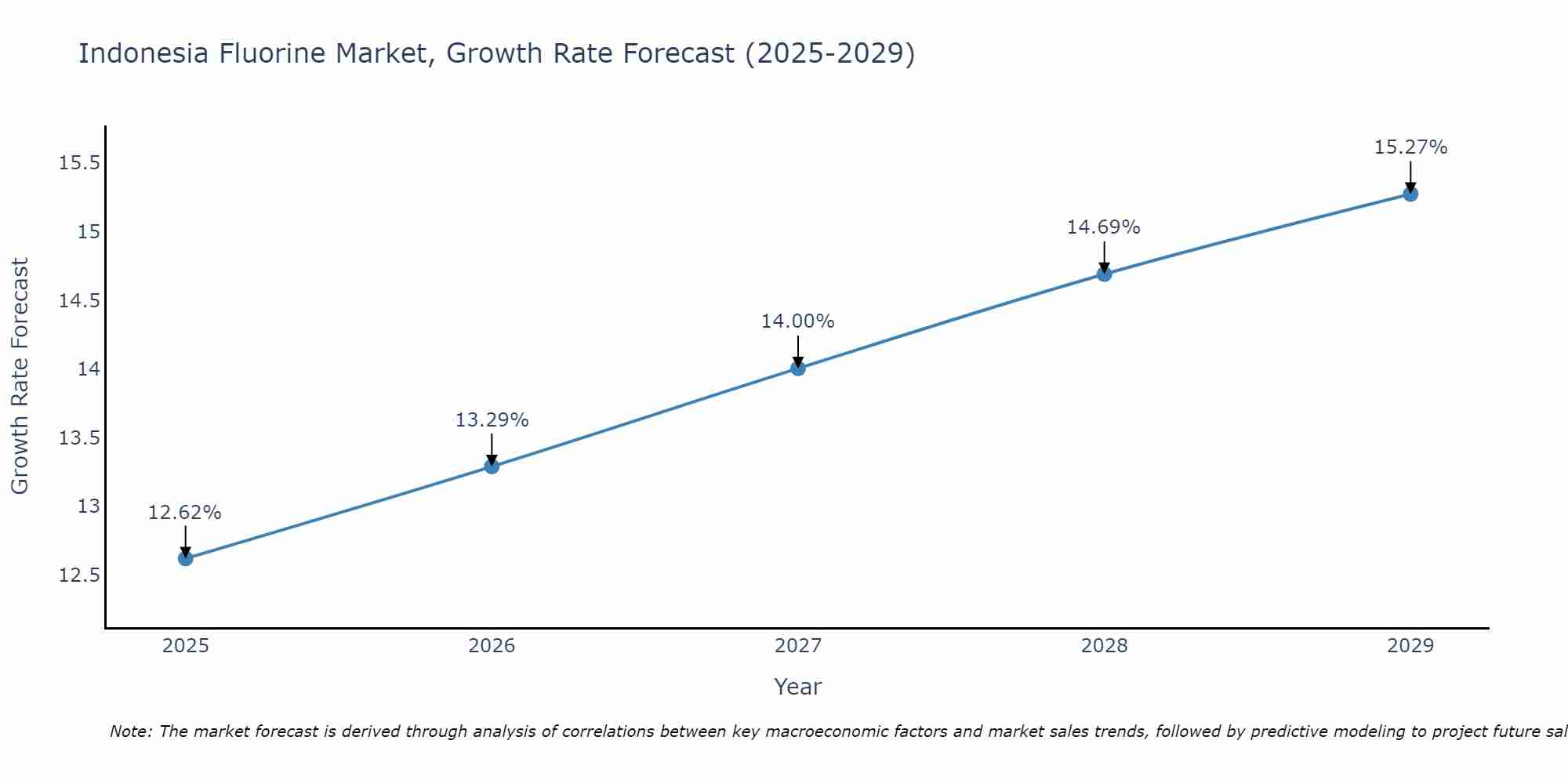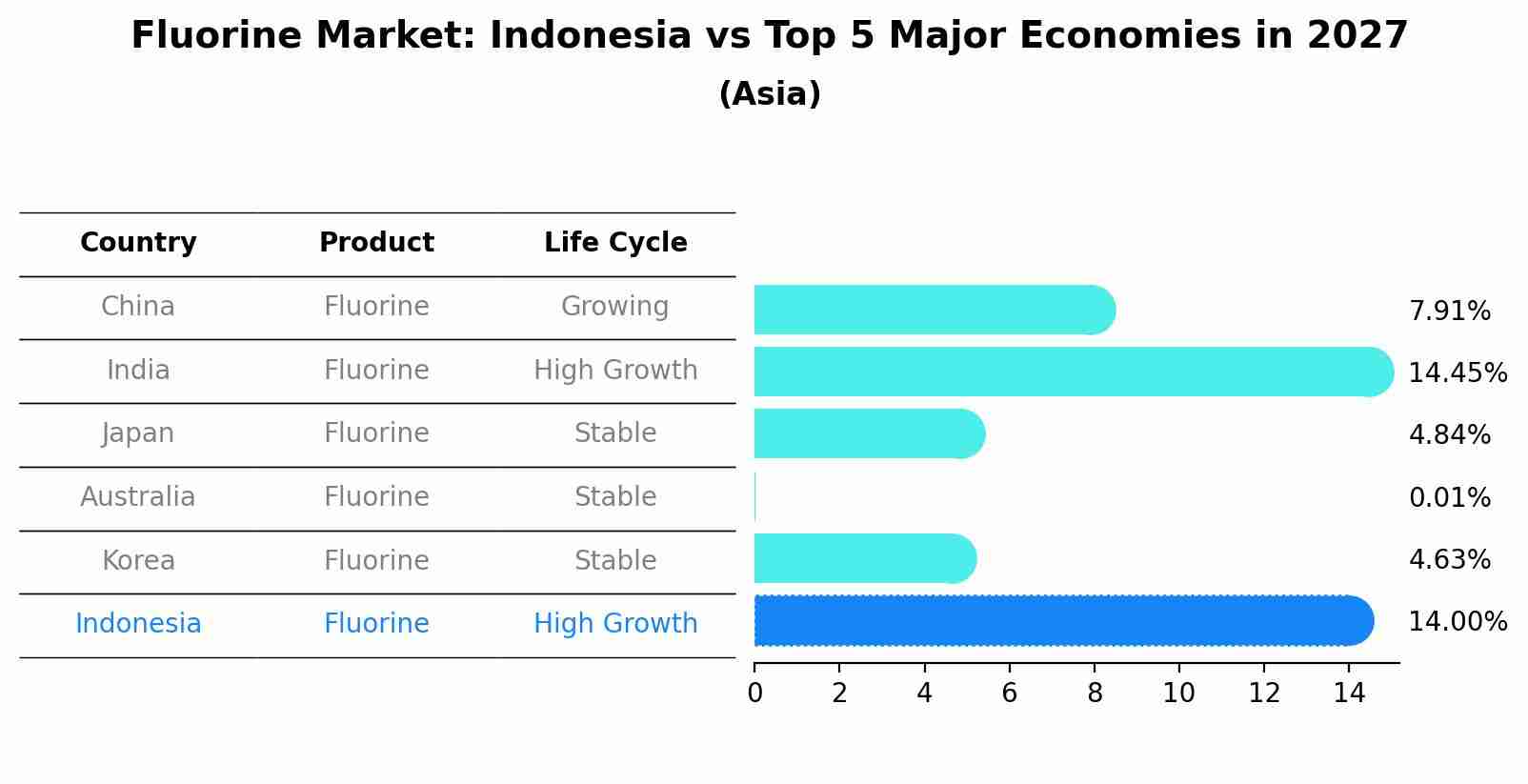Indonesia Fluorine Market (2025-2031) Outlook | Industry, Value, Analysis, Share, Revenue, Size, Forecast, Growth, Trends & Companies
| Product Code: ETC103487 | Publication Date: Jul 2023 | Updated Date: Apr 2025 | Product Type: Report | |
| Publisher: 6Wresearch | No. of Pages: 70 | No. of Figures: 35 | No. of Tables: 5 | |
Indonesia Fluorine Market Size Growth Rate
The Indonesia Fluorine Market is poised for steady growth rate improvements from 2025 to 2029. From 12.62% in 2025, the growth rate steadily ascends to 15.27% in 2029.

Fluorine Market: Indonesia vs Top 5 Major Economies in 2027 (Asia)
The Fluorine market in Indonesia is projected to grow at a high growth rate of 14.00% by 2027, highlighting the country's increasing focus on advanced technologies within the Asia region, where China holds the dominant position, followed closely by India, Japan, Australia and South Korea, shaping overall regional demand.

Indonesia Fluorine MarketSynopsis
The fluorine market in Indonesia refers to the industry involved in the production, distribution, and utilization of fluorine-based compounds and products. Fluorine is an essential element used in various industries, including chemicals, metallurgy, pharmaceuticals, electronics, and construction.
Market Trends
Fluoropolymers, such as polytetrafluoroethylene (PTFE) and polyvinylidene fluoride (PVDF), are witnessing increased demand due to their unique properties, including high temperature resistance, chemical inertness, and electrical insulation. These materials find applications in sectors like automotive, electronics, and construction. Advances in fluorine chemistry are driving innovation in various industries. This includes the development of new fluorinated compounds, catalysts, and materials with enhanced properties, which can influence the demand for fluorine in specific applications.
Market Drivers
Indonesia growing industrial and infrastructure sectors drive the demand for fluorine-based products. These sectors require fluorine for applications such as corrosion-resistant coatings, electrical components, and specialty chemicals. The expanding electronics and semiconductor industries rely on fluorine-based materials for their unique properties. Fluorine plays a crucial role in the manufacturing of semiconductors, integrated circuits, and electronic components. Fluorine is used in pharmaceuticals for the development of fluorinated drugs and radiopharmaceuticals. The healthcare sector`s demand for fluorine-based compounds and medical imaging agents contributes to the market growth.
COVID-19 Impact on the Market
The COVID-19 pandemic had varying impacts on the fluorine market in Indonesia. While certain sectors, such as electronics, experienced disruptions in supply chains and reduced demand, other sectors like healthcare and pharmaceuticals witnessed increased demand for fluorine-based products. The recovery of industrial activities and the resumption of infrastructure projects are expected to drive the market`s recovery.
Challenges of the Market
Fluorine-based compounds can have environmental and health implications if not managed properly. Handling, storage, and disposal of fluorine-containing substances require adherence to safety regulations and proper waste management practices. Some applications that traditionally relied on fluorine-based materials may face competition from alternative materials with comparable or improved properties. The market needs to address the challenges posed by substitute materials to maintain market share.
Industry Key Players
PT Asahimas Chemical, PT Arkema Indonesia, PT Daikin Indonesia, PT Fluoropolymer Indonesia, PT Asahi Glass Indonesia.
Key Highlights of the Report:
- Indonesia Fluorine Market Outlook
- Market Size of Indonesia Fluorine Market, 2024
- Forecast of Indonesia Fluorine Market, 2031
- Historical Data and Forecast of Indonesia Fluorine Revenues & Volume for the Period 2021-2031
- Indonesia Fluorine Market Trend Evolution
- Indonesia Fluorine Market Drivers and Challenges
- Indonesia Fluorine Price Trends
- Indonesia Fluorine Porter's Five Forces
- Indonesia Fluorine Industry Life Cycle
- Historical Data and Forecast of Indonesia Fluorine Market Revenues & Volume By Product Type for the Period 2021-2031
- Historical Data and Forecast of Indonesia Fluorine Market Revenues & Volume By Fluorite for the Period 2021-2031
- Historical Data and Forecast of Indonesia Fluorine Market Revenues & Volume By Cryolite for the Period 2021-2031
- Historical Data and Forecast of Indonesia Fluorine Market Revenues & Volume By Fluorapatite for the Period 2021-2031
- Historical Data and Forecast of Indonesia Fluorine Market Revenues & Volume By Application for the Period 2021-2031
- Historical Data and Forecast of Indonesia Fluorine Market Revenues & Volume By Synthetic Chemical Materials for the Period 2021-2031
- Historical Data and Forecast of Indonesia Fluorine Market Revenues & Volume By Pharmaceuticals for the Period 2021-2031
- Historical Data and Forecast of Indonesia Fluorine Market Revenues & Volume By Pesticides for the Period 2021-2031
- Historical Data and Forecast of Indonesia Fluorine Market Revenues & Volume By Plastic for the Period 2021-2031
- Historical Data and Forecast of Indonesia Fluorine Market Revenues & Volume By Electronic Cleaning for the Period 2021-2031
- Historical Data and Forecast of Indonesia Fluorine Market Revenues & Volume By Others for the Period 2021-2031
- Indonesia Fluorine Import Export Trade Statistics
- Market Opportunity Assessment By Product Type
- Market Opportunity Assessment By Application
- Indonesia Fluorine Top Companies Market Share
- Indonesia Fluorine Competitive Benchmarking By Technical and Operational Parameters
- Indonesia Fluorine Company Profiles
- Indonesia Fluorine Key Strategic Recommendations
Frequently Asked Questions About the Market Study (FAQs):
1 Executive Summary |
2 Introduction |
2.1 Key Highlights of the Report |
2.2 Report Description |
2.3 Market Scope & Segmentation |
2.4 Research Methodology |
2.5 Assumptions |
3 Indonesia Fluorine Market Overview |
3.1 Indonesia Country Macro Economic Indicators |
3.2 Indonesia Fluorine Market Revenues & Volume, 2021 & 2031F |
3.3 Indonesia Fluorine Market - Industry Life Cycle |
3.4 Indonesia Fluorine Market - Porter's Five Forces |
3.5 Indonesia Fluorine Market Revenues & Volume Share, By Product Type, 2021 & 2031F |
3.6 Indonesia Fluorine Market Revenues & Volume Share, By Application, 2021 & 2031F |
4 Indonesia Fluorine Market Dynamics |
4.1 Impact Analysis |
4.2 Market Drivers |
4.3 Market Restraints |
5 Indonesia Fluorine Market Trends |
6 Indonesia Fluorine Market, By Types |
6.1 Indonesia Fluorine Market, By Product Type |
6.1.1 Overview and Analysis |
6.1.2 Indonesia Fluorine Market Revenues & Volume, By Product Type, 2018 - 2031F |
6.1.3 Indonesia Fluorine Market Revenues & Volume, By Fluorite, 2018 - 2031F |
6.1.4 Indonesia Fluorine Market Revenues & Volume, By Cryolite, 2018 - 2031F |
6.1.5 Indonesia Fluorine Market Revenues & Volume, By Fluorapatite, 2018 - 2031F |
6.2 Indonesia Fluorine Market, By Application |
6.2.1 Overview and Analysis |
6.2.2 Indonesia Fluorine Market Revenues & Volume, By Synthetic Chemical Materials, 2018 - 2031F |
6.2.3 Indonesia Fluorine Market Revenues & Volume, By Pharmaceuticals, 2018 - 2031F |
6.2.4 Indonesia Fluorine Market Revenues & Volume, By Pesticides, 2018 - 2031F |
6.2.5 Indonesia Fluorine Market Revenues & Volume, By Plastic, 2018 - 2031F |
6.2.6 Indonesia Fluorine Market Revenues & Volume, By Electronic Cleaning, 2018 - 2031F |
6.2.7 Indonesia Fluorine Market Revenues & Volume, By Others, 2018 - 2031F |
7 Indonesia Fluorine Market Import-Export Trade Statistics |
7.1 Indonesia Fluorine Market Export to Major Countries |
7.2 Indonesia Fluorine Market Imports from Major Countries |
8 Indonesia Fluorine Market Key Performance Indicators |
9 Indonesia Fluorine Market - Opportunity Assessment |
9.1 Indonesia Fluorine Market Opportunity Assessment, By Product Type, 2021 & 2031F |
9.2 Indonesia Fluorine Market Opportunity Assessment, By Application, 2021 & 2031F |
10 Indonesia Fluorine Market - Competitive Landscape |
10.1 Indonesia Fluorine Market Revenue Share, By Companies, 2024 |
10.2 Indonesia Fluorine Market Competitive Benchmarking, By Operating and Technical Parameters |
11 Company Profiles |
12 Recommendations |
13 Disclaimer |
- Single User License$ 1,995
- Department License$ 2,400
- Site License$ 3,120
- Global License$ 3,795
Search
Related Reports
- Middle East OLED Market (2025-2031) | Outlook, Forecast, Revenue, Growth, Companies, Analysis, Industry, Share, Trends, Value & Size
- Taiwan Electric Truck Market (2025-2031) | Outlook, Industry, Revenue, Size, Forecast, Growth, Analysis, Share, Companies, Value & Trends
- South Korea Electric Bus Market (2025-2031) | Outlook, Industry, Companies, Analysis, Size, Revenue, Value, Forecast, Trends, Growth & Share
- Vietnam Electric Vehicle Charging Infrastructure Market (2025-2031) | Outlook, Analysis, Forecast, Trends, Growth, Share, Industry, Companies, Size, Value & Revenue
- Vietnam Meat Market (2025-2031) | Companies, Industry, Forecast, Value, Trends, Analysis, Share, Growth, Revenue, Size & Outlook
- Vietnam Spices Market (2025-2031) | Companies, Revenue, Share, Value, Growth, Trends, Industry, Forecast, Outlook, Size & Analysis
- Iran Portable Fire Extinguisher Market (2025-2031) | Value, Forecast, Companies, Industry, Analysis, Trends, Growth, Revenue, Size & Share
- Philippines Animal Feed Market (2025-2031) | Companies, industry, Size, Share, Revenue, Analysis, Forecast, Growth, Outlook
- India Lingerie Market (2025-2031) | Companies, Growth, Forecast, Outlook, Size, Value, Revenue, Share, Trends, Analysis & Industry
- India Smoke Detector Market (2025-2031) | Trends, Share, Analysis, Revenue, Companies, Industry, Forecast, Size, Growth & Value
Industry Events and Analyst Meet
Our Clients
Whitepaper
- Middle East & Africa Commercial Security Market Click here to view more.
- Middle East & Africa Fire Safety Systems & Equipment Market Click here to view more.
- GCC Drone Market Click here to view more.
- Middle East Lighting Fixture Market Click here to view more.
- GCC Physical & Perimeter Security Market Click here to view more.
6WResearch In News
- Doha a strategic location for EV manufacturing hub: IPA Qatar
- Demand for luxury TVs surging in the GCC, says Samsung
- Empowering Growth: The Thriving Journey of Bangladesh’s Cable Industry
- Demand for luxury TVs surging in the GCC, says Samsung
- Video call with a traditional healer? Once unthinkable, it’s now common in South Africa
- Intelligent Buildings To Smooth GCC’s Path To Net Zero













